GRAPHING LINEAR FUNCTIONS WORKSHEET
Subscribe to our ▶️ YouTube channel 🔴 for the latest videos, updates, and tips.
1. Graph the linear function y = (2/3)x - 1.
2. Graph the linear function y = (-5/2)x + 3.
3. Ken has a weekly goal of burning 2400 calories by taking brisk walks. The equation y = -300x + 2400 represents the number of calories y Ken has left to burn after x hours of walking which burns 300 calories per hour. After how many hours of walking will Ken have 600 calories left to burn ? After how many hours will he reach his weekly goal?
4. The temperature at dawn was 8 °F and increased steadily 2 °F every hour. The equation y = 2x + 8 gives the temperature y after x hours. State whether the relationship between the time and the temperature is proportional or non proportional. Then graph the function.
5. The temperature of a fish tank was 82 °F and decreased steadily 2 °F every hour. The equation y = -2x + 82 gives the temperature y after x hours. State whether the relationship between the time and the temperature is proportional or non proportional. Then graph the function.

1. Answer :
y = (2/3)x - 1
Step 1 :
The y-intercept is b = -1. Plot the point that contains the y-intercept : (0, -1).
Step 2 :
The slope is m = 2/3. Use the slope to find second a point. Since the slope = rise/run, from (0, -1), count up 2 units and right 3 units.
Then, the new point is (3, 1).
Step 3 :
Draw a line through the points.

2. Answer :
y = (-5/2)x + 3
Step 1 :
The y-intercept is b = 3. Plot the point that contains the y-intercept : (0, 3).
Step 2 :
The slope is m = -5/2. Use the slope to find second a point. Since the slope = rise/run, from (0, 3), count down 5 units and right 2 units or up 5 units and left 2 units.
Then, the new point is (2, -1) or (-2, 8).
Step 3 :
Draw a line through the points.
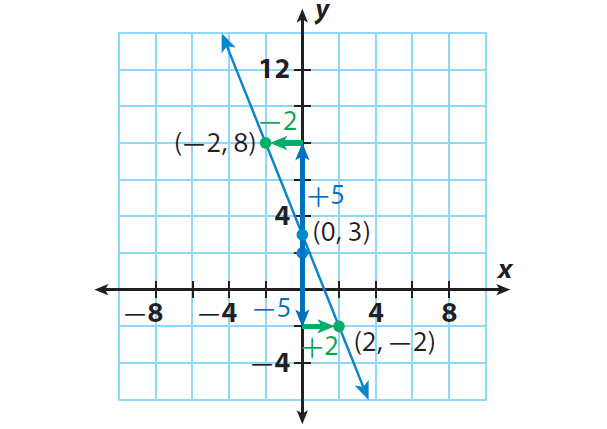
3. Answer :
Step 1 :
y = -300x + 2400
The y-intercept is b = 2400. Plot the point that contains the y-intercept : (0, 2400).
Step 2 :
Write the slope as a fraction.
m = -300/1 = -600/2 = -900/3
Using the slope as -900/3 helps in drawing a more accurate graph.
The slope is m = -900/3. Use the slope to find second a point. Since the slope = rise / run, from (0, 2400), count down 900 units and right 3 units.
Then, the new point is (3, 1500).
Step 3 :
Draw a line through the points.
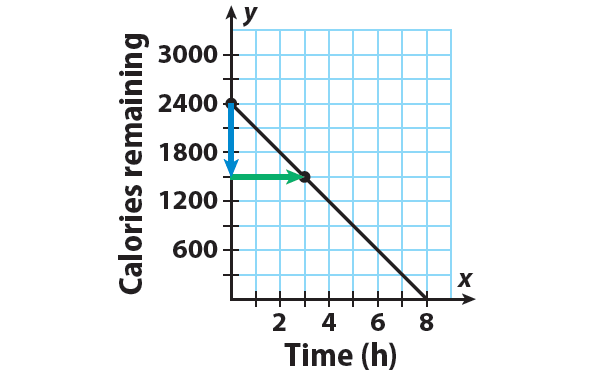
Step 4 :
To find after how many hours of walking will Ken have 600 calories left to burn.
Locate 600 calories on the y-axis. Read across and down to the x-axis.
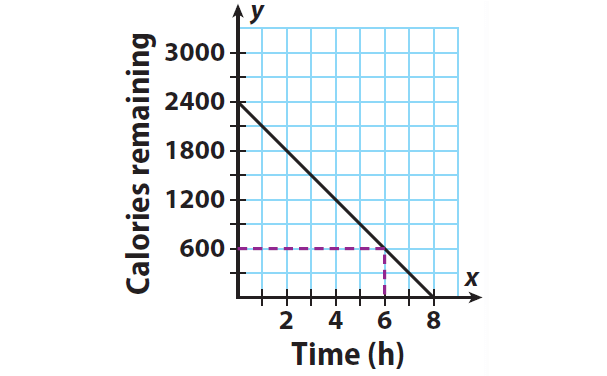
From the graph, we can know that Ken will have 600 calories left to burn after 6 hours.
Step 5 :
Ken will reach his weekly goal when the number of calories left to burn is 0. Because every point on the x-axis has a y-value of 0, find the point where the line crosses the x-axis.
Ken will reach his goal after 8 hours of brisk walking.
4. Answer :
Step 1 :
The given equation y = 2x + 8 is in slope-intercept form linear equation. That is, y = mx + b.
When we compare the equation y = 2x + 8 with y = mx + b, we get m = 2 and b = 8.
Therefore, the equation is a linear equation. Since b ≠ 0, the relationship is non proportional.
Step 2 :
Choose several values for the input x. Plug these values for x in the equation to find the output y.
x
0
2
4
6
2x + 8
2(0) + 8
2(2) + 8
2(4) + 8
2(6) + 8
y
8
12
16
20
(x, y)
(0, 8)
(2, 12)
(4, 16)
(6, 20)
Step 3 :
Graph the ordered pairs. Then draw a line through the points to represent the solutions of the function.
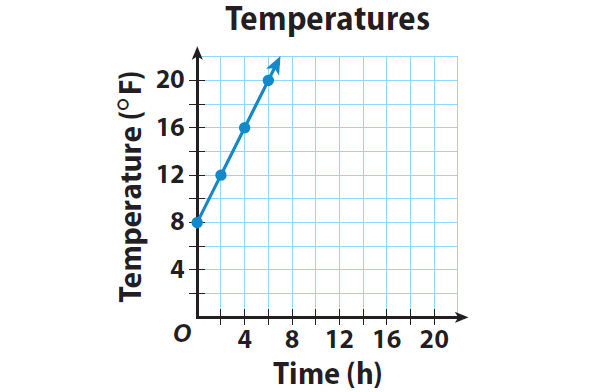
5. Answer :
Step 1 :
The given equation y = -2x + 82 is in slope-intercept form linear equation. That is, y = mx + b.
When we compare the equation y = -2x + 82 with y = mx + b, we get m = -2 and b = 82.
Therefore, the equation is a linear equation. Since b ≠ 0, the relationship is non proportional.
Step 2 :
Choose several values for the input x. Plug these values for x in the equation to find the output y.
x
0
1
2
3
4
5
-2x + 82
-2(0) + 82
-2(1) + 82
-2(2) + 82
-2(3) + 82
-2(4) + 82
-2(5) + 82
y
82
80
78
76
74
72
(x, y)
(0, 82)
(1, 80)
(2, 78)
(3, 76)
(4, 74)
(5, 72)
Step 3 :
Graph the ordered pairs. Then draw a line through the points to represent the solutions of the function.
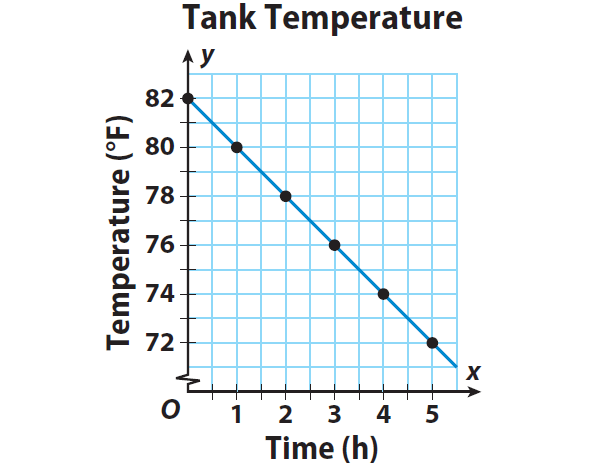
Subscribe to our ▶️ YouTube channel 🔴 for the latest videos, updates, and tips.
Kindly mail your feedback to v4formath@gmail.com
We always appreciate your feedback.
About Us | Contact US | Privacy Policy
©All rights reserved. onlinemath4all.com
Recent Articles
-
10 Hard SAT Math Questions (Part - 39)
Dec 11, 25 05:59 PM
10 Hard SAT Math Questions (Part - 39) -
10 Hard SAT Math Questions (Part - 38)
Dec 08, 25 12:12 AM
10 Hard SAT Math Questions (Part - 38) -
SAT Math Practice
Dec 05, 25 04:04 AM
SAT Math Practice - Different Topics - Concept - Formulas - Example problems with step by step explanation

